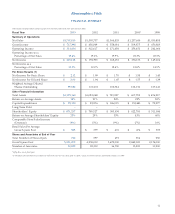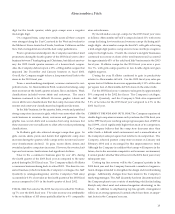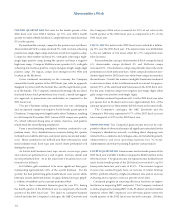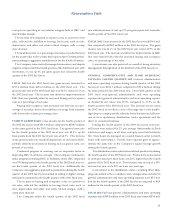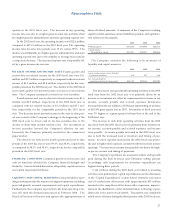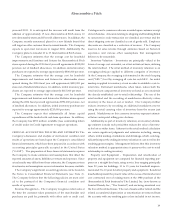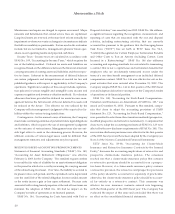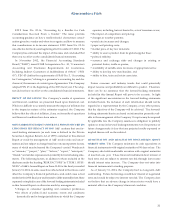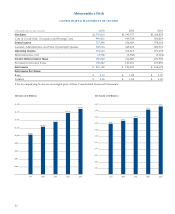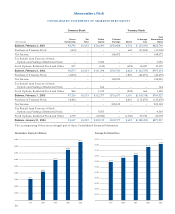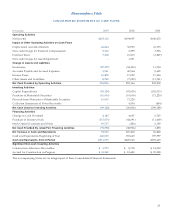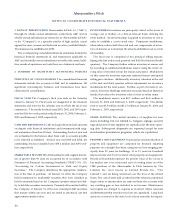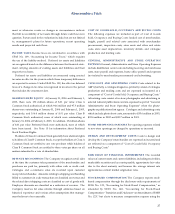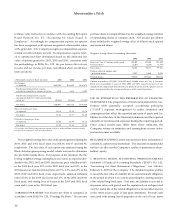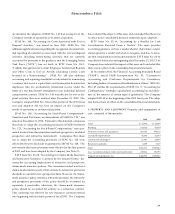Abercrombie & Fitch 2003 Annual Report Download - page 21
Download and view the complete annual report
Please find page 21 of the 2003 Abercrombie & Fitch annual report below. You can navigate through the pages in the report by either clicking on the pages listed below, or by using the keyword search tool below to find specific information within the annual report.
year-end 2003. It is anticipated the increase will result from the
addition of approximately 15 new Abercrombie & Fitch stores, 10
new abercrombie stores and 85 new Hollister stores. In addition, the
Company recently announced plans for a new lifestyle brand that
will target an older customer than its current brands. The Company
expects to open four test stores in August 2004. Additionally, the
Company plans to remodel 10 to 15 Abercrombie & Fitch stores.
The Company estimates that the average cost for leasehold
improvements and furniture and fixtures for Abercrombie & Fitch
stores opened during the 2004 fiscal year will approximate $550,000
per store, net of landlord allowances. In addition, initial inventory
purchases are expected to average approximately $300,000 per store.
The Company estimates that the average cost for leasehold
improvements and furniture and fixtures for abercrombie stores
opened during the 2004 fiscal year will approximate $450,000 per
store, net of landlord allowances. In addition, initial inventory pur-
chases are expected to average approximately $115,000 per store.
The Company estimates that the average cost for leasehold
improvements and furniture and fixtures for Hollister stores opened
during the 2004 fiscal year will approximate $590,000 per store, net
of landlord allowances. In addition, initial inventory purchases are
expected to average approximately $215,000 per store.
The Company expects that substantially all future capital
expenditures will be funded with cash from operations. In addition,
the Company has $250 million available (less outstanding letters
of credit) under its Credit Agreement to support operations.
CRITICAL ACCOUNTING POLICIES AND ESTIMATES The
Company’s discussion and analysis of its financial condition and
results of operations are based upon the Company’s consolidated
financial statements, which have been prepared in accordance with
accounting principles generally accepted in the United States
(“GAAP”). The preparation of these financial statements requires
the Company to make estimates and assumptions that affect the
reported amounts of assets, liabilities, revenues and expenses. Since
actual results may differ from those estimates, the Company revises
its estimates and assumptions as new information becomes available.
The Company’s significant accounting policies can be found in
the Notes to Consolidated Financial Statements (see Note 2).
The Company believes that the following policies are most criti-
cal to the portrayal of the Company’s financial condition and
results of operations.
Revenue Recognition - The Company recognizes retail sales at
the time the customer takes possession of the merchandise and
purchases are paid for, primarily with either cash or credit card.
Catalogue and e-commerce sales are recorded upon customer receipt
of merchandise. Amounts relating to shipping and handling billed
to customers in a sale transaction are classified as revenue and the
direct shipping costs are classified as cost of goods sold. Employee
discounts are classified as a reduction of revenue. The Company
reserves for sales returns through estimates based on historical
experience and various other assumptions that management
believes to be reasonable.
Inventory Valuation - Inventories are principally valued at the
lower of average cost or market, on a first-in first-out basis, utilizing
the retail method. The retail method of inventory valuation is an
averaging technique applied to different categories of inventory.
At the Company, the averaging is determined at the stock keeping
unit (“SKU”) level by averaging all costs for each SKU. An initial
markup is applied to inventory at cost in order to establish a cost-to-
retail ratio. Permanent markdowns, when taken, reduce both the
retail and cost components of inventory on hand so as to maintain
the already established cost-to-retail relationship. The use of the
retail method and the recording of markdowns effectively values
inventory at the lower of cost or market. The Company further
reduces inventory by recording an additional markdown reserve
using the retail carrying value of inventory from the season just
passed. Markdowns on this carryover inventory represent estimat-
ed future anticipated selling price declines.
Additionally, as part of inventory valuation, an inventory shrink-
age estimate is made each period that reduces the value of invento-
ry for lost or stolen items. Inherent in the retail method calculation
are certain significant judgments and estimates including, among
others, initial markup, markdowns and shrinkage, which could sig-
nificantly impact the ending inventory valuation at cost as well as the
resulting gross margins. Management believes that this inventory
valuation method is appropriate since it preserves the cost-to-retail
relationship in ending inventory.
Property and Equipment - Depreciation and amortization of
property and equipment are computed for financial reporting pur-
poses on a straight-line basis, using service lives ranging principally
from 30 years for buildings, 10 to 15 years for leasehold improve-
ments and 3 to 10 years for other property and equipment. Beneficial
leaseholds represent the present value of the excess of fair market rent
over contractual rent of existing stores at the 1988 purchase of the
Abercrombie & Fitch business by The Limited, Inc. (now known as
Limited Brands, Inc., “The Limited”) and are being amortized over
the lives of the related leases. The cost of assets sold or retired and the
related accumulated depreciation or amortization are removed from
the accounts with any resulting gain or loss included in net income.
Abercrombie &Fitch
19




